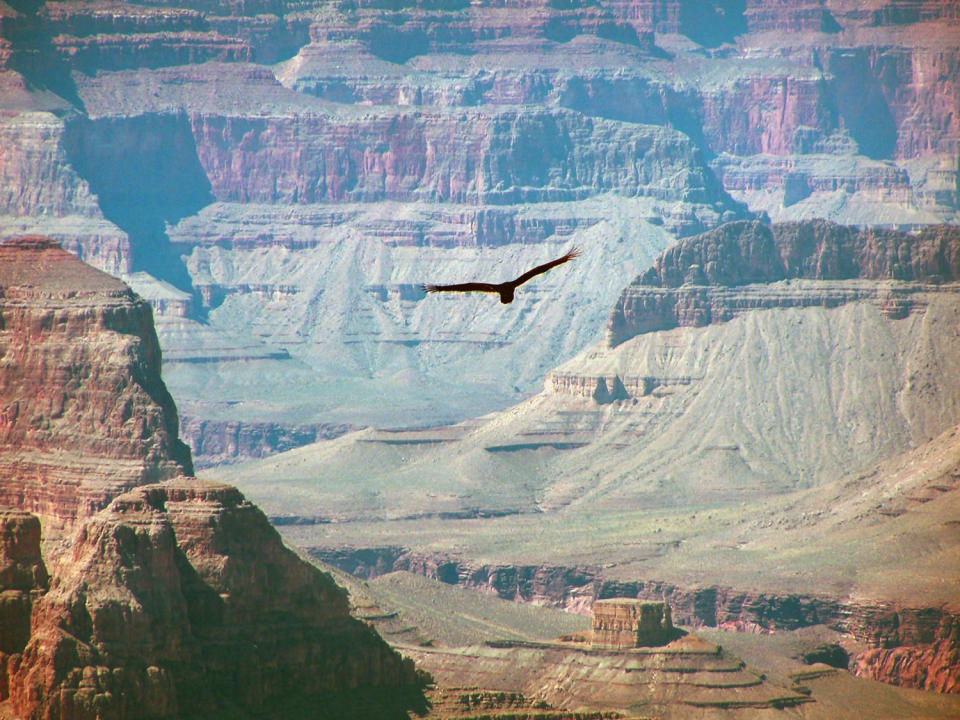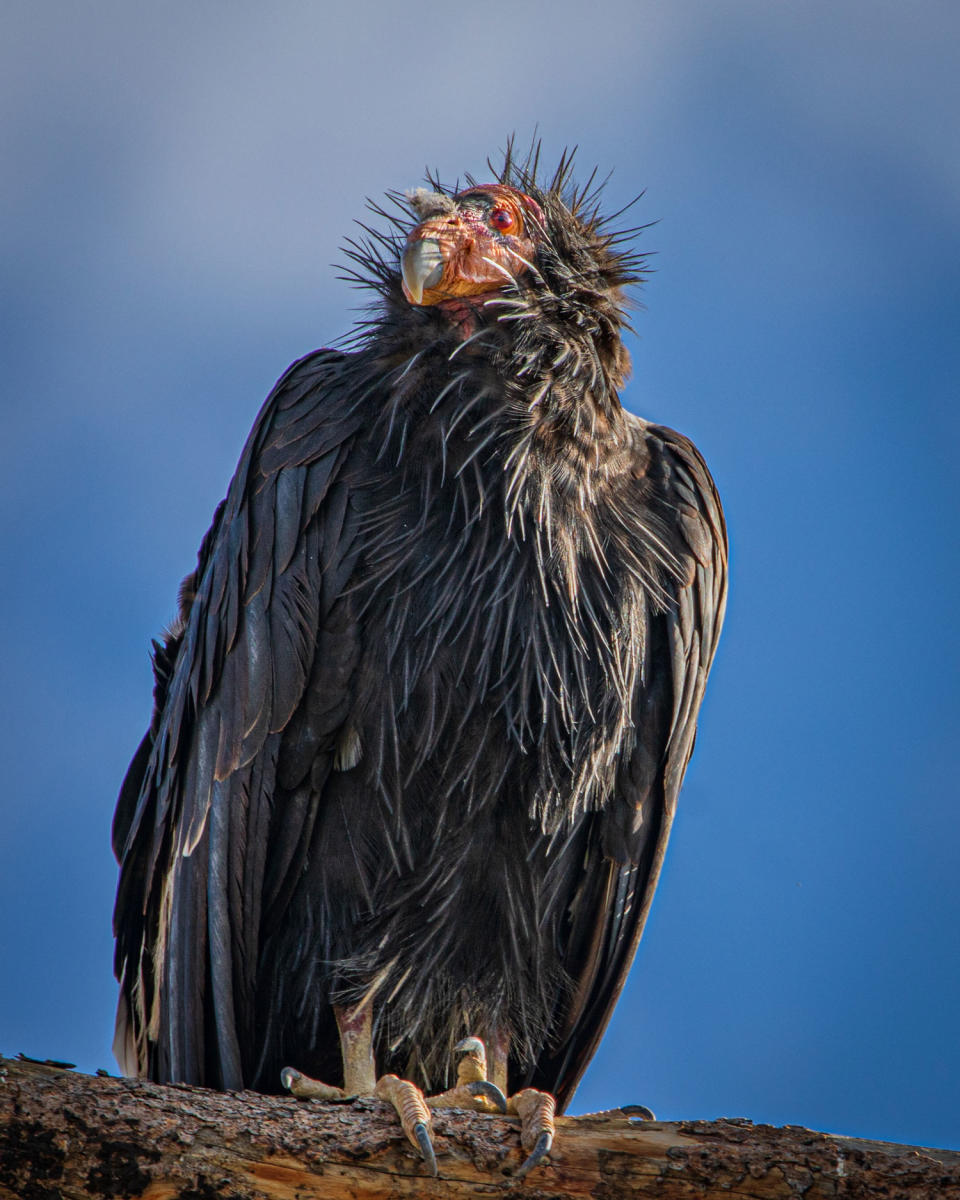California Condors in The Grand Canyon
This article originally appeared on My Grand Canyon
Stand on any South Rim overlook and turn your eyes to the sky. If you’re lucky, you might spot a huge black shape riding the thermals over the canyon. Look closer: bald red head, wide wingspan, triangular white patches under the wings – it’s a California condor. And that makes you very lucky indeed, because the condor is one of the rarest birds in the world.
About 92 condors inhabited the skies of northern Arizona and Utah in 2019. That might sound small, but the number represents a smashing success. Not so long ago, there weren’t any condors at the Grand Canyon. In fact, in 1982, only 22 condors remained in the world. Thanks to quick action from the U.S. Fish and Wildlife Service and several partner zoos, a captive breeding and reintroduction program pulled the magnificent birds back from the edge of extinction. Today, the world population stands at 500 condors, if you include those living in captivity, and more than half of them are living wild in California, Utah, Arizona and Baja California, as of 2022.

Condors used to soar over most of the Lower 48 states until about 10,000 years ago, when their numbers dropped dramatically right around the time that mastodons and saber-tooth cats went extinct. But populations remained steady on the West Coast, from British Columbia to Mexico, until European settlers moved in. After that, condor numbers plunged because of hunting, poisoning, habitat loss, and especially lead poisoning. Like vultures, condors are scavengers that feed on carrion; when they dined on animals shot with lead bullets, the birds ingested the toxic lead, too.
The population dwindled and near the end of the 1930s it was reported that no condors lived outside of California. The condor, which had once roamed across a large portion of North America, was nearly extinct.

Saving the Condor Population
In 1967 after the condors’ numbers had fallen into the double digits, the condor was placed on the federal endangered species list and scientists banded together to try and help solve the problem of the condor’s dwindling population. In 1983 the U.S. Fish and Wildlife Service began an initiative to breed the condors in captivity with help from the San Diego Wild Animal Park and Los Angeles Zoo.
Condors typically mate for life and lay one egg roughly every year or so, so scientists knew that in order to bring the population back to sustainable numbers they would need to streamline the process. In order to do this, scientists would take the egg from the birds once they were laid and use an incubator to look after the egg until it hatched. When the egg hatches the scientists use a large hand puppet in the shape of a condor to raise the baby bird. The parents continue to lay eggs– sometimes up to three eggs a year.
But it wasn’t always smooth sailing. In 1985 only nine wild birds remained and in a controversial decision scientists decided to bring them into captivity. From 1987 to 1992 condors could only be found in captivity. During this time the population increased from 27 to approximately 150 condors helping stabilize the population.
Reintroducing Condors into the Wild
In 1992 several condors were released back into the wild within California. In 1996 the first batch of six captivity-bred condors were released within Arizona 30 miles from the Grand Canyon. The release meant wild condors were flying over the Grand Canyon for the first time in 70 years. Since the initial release, approximately 70 condors now inhabit parts of Arizona and Utah. There have even been several wild-born condors within the Grand Canyon. Though there are still roughly 100 condors in captivity, more than 100 condors are wild within the southwest and Baja California.
The Utah Department of Wildlife Resources put together this video about the return of the California Condor to Utah.
Spotting a Condor
The Grand Canyon is so big it can be tough to spot a condor, but experts suggest some of the best places are along the South Rim near the Bright Angel Trail. During hot summer months the condors typically can be seen floating along convection currents high above Indian Gardens far below. Though sometimes condors can be mistaken for vultures, the most efficient way to identify them is to look for white spots on the underside of their wings.
IDing Condors by Their Number Tags
Sharp-eyed condor fans can get to know the area’s birds. If you can see the identification number on each condor’s wing, you can learn the bird’s history, including its age, sex, parents, and whether it hatched in the wild or in captivity. Go to science.peregrinefund.org/condor-list for ID information.
Condor Trivia | |
Size | Up to 23 pounds; wingspan 9.5-10 feet |
Lifespan | 60 years |
Top Speed | 50 mph |
Habitat | U.S. (California, Arizona, Utah) and Mexico |
Food | Scavenges dead deer, cattle, rabbits, and rodents |
Reproduction | Pairs mate for life. Females lay one egg every other year and both parents care for chicks |
Biggest threat | Lead poisoning |
Where to see them in Arizona | Grand Canyon NP’s Yaki Point, Yavapai Point, and Lookout Studio; Vermilion Cliffs NM; Kaibab National Forest; Glen Canyon NCA |
For exclusive access to all of our fitness, gear, adventure, and travel stories, plus discounts on trips, events, and gear, sign up for Outside+ today.

